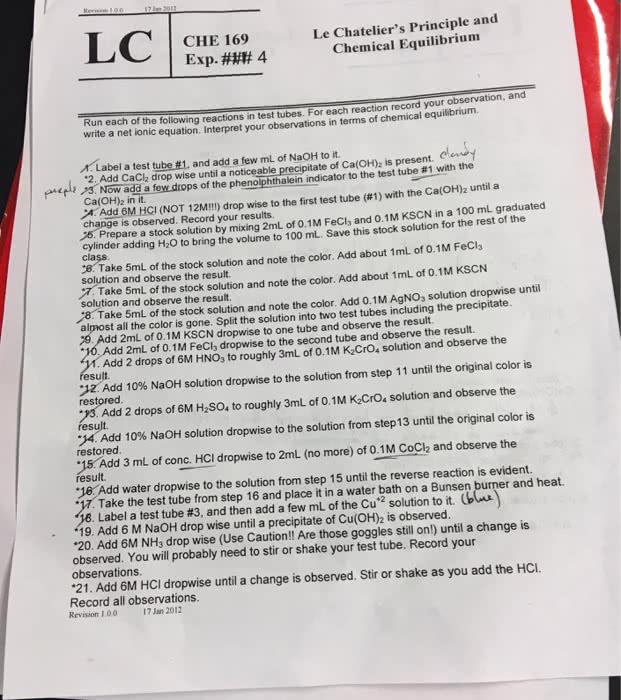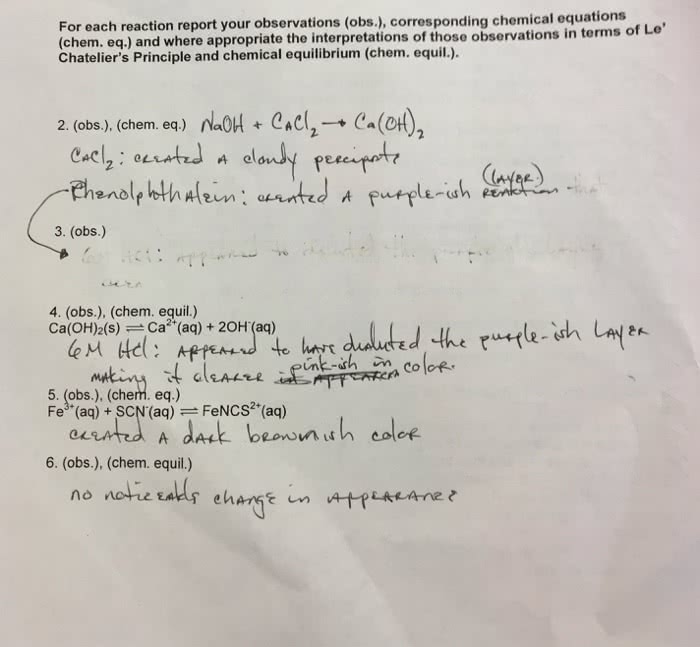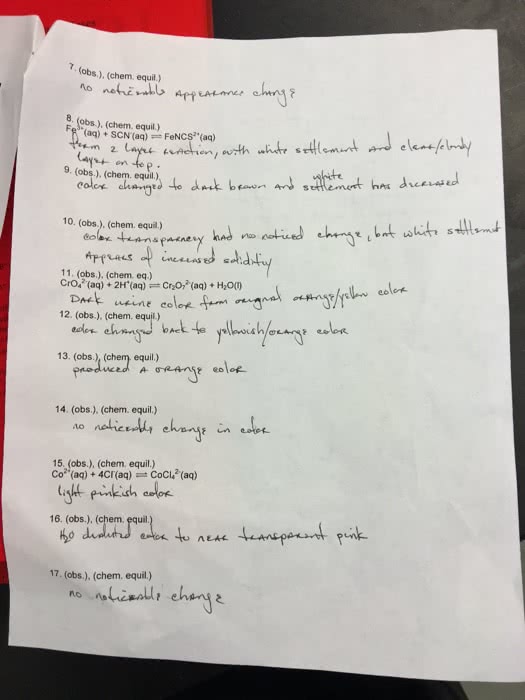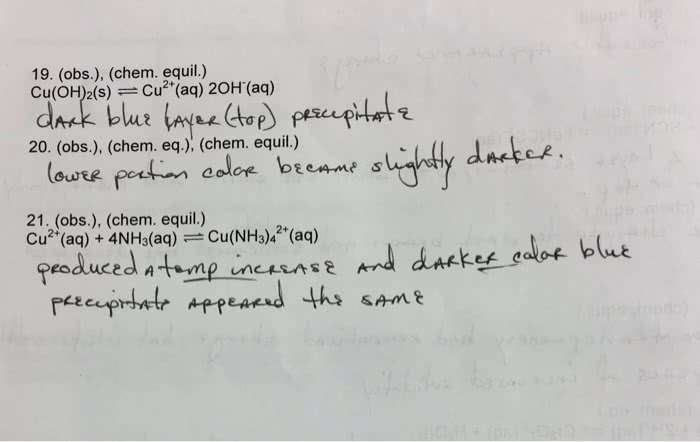Please check my work. I am have to bring my grade up so I need to make sure I get these right this week Here are my notes and answers from lab this week please let me know if I missed any.
NOTES:
Experiment 1: The Effect of Temperature on Catalase Activity
Test tube #1(10ðC)
Add 5 mL of 3% hydrogen peroxide
Add 5 mL of water
Add 1 mL of catalase
Observe bubbles: No bubbles observed (or very, very little)
Color changed to red
Test Tube #2 (21.5ðC)
Add 5 mL of 3% hydrogen peroxide
Add 5 mL of water
Add 1 mL of catalase
Observe bubbles: Bubbles appeared quickly and constantly for the first 10 seconds then stopped
Color changed to red
Test Tube #3 (40ðC)
Add 5 mL of 3% hydrogen peroxide
Add 5 mL of water
Add 1 mL of catalase
Observe bubbles:Bubbles appeared slowly and Sporadically for about 10 seconds then stopped.
Color changed to red
Test Tube #4(60ðC)
Add 5 mL of 3% hydrogen peroxide
Add 5 mL of water
Add 1 mL of catalase
Observe bubbles: Bubbles appeared instantly and continued sporadically continued for 10 seconds
color changed to red
Test Tube #5 (80ðC)
Add 5 mL of 3% hydrogen peroxide
Add 5 mL of water
Add 1 mL of catalase
Observe bubbles:Bubbles appeared instantly, and sporadically continued for about 10 seconds then stopped.
Color of solution changed to red.
Experiment 2: The Effect of Substrate Concentration on Catalase Activity
Test Tube #1
Add 8mL Water
Add 2mL 3% Hydrogen Peroxide (mL)
Add 0.1 mL of catalase
Time for bubbles to stop forming: .38 seconds
Test Tube #2
Add 5mL Water
Add 5mL 3% Hydrogen Peroxide (mL)
Add 0.1 mL of catalase
Time for bubbles to stop forming: 32 seconds
Test Tube #3
Add 2mL Water
Add 8mL 3% Hydrogen Peroxide (mL)
Add 0.1 mL of catalase
Time for bubbles to stop forming: 28 seconds
Test Tube #4
Add 0mL Water
Add 10mL 3% Hydrogen Peroxide (mL)
Add 0.1 mL of catalase
Time for bubbles to stop forming: No bubbles
Experiment 3: The Effect of pH on Catalase Activity
Test Tube #1 (21.5ðC)
Add 5 mL of 3% hydrogen peroxide
Add 5 mL of pH 2 buffer
Add 1 mL of Catalase Solution
Observation: No bubbles
Test Tube #2 (40ðC)
Add 5 mL of 3% hydrogen peroxide
Add 5 mL of pH 6 buffer
Add 1 mL of Catalase Solution
Observation: bubbles appear immediately
Test Tube #3 (60ðC)
Add 5 mL of 3% hydrogen peroxide
Add 10mL of pH 10 buffer
Add 1 mL of Catalase Solution
Observation: no bubbles.
Experiment 1: The Effect of Temperature on Catalase Activity
Lab Results
At which temperatures did catalase function somewhat, but not optimally?
40 degrees the bubbles appeared slowly and continued sporadically for about 10 seconds before stopping. At 60 & 80 degrees the bubbles appeared immediately but were sporadic as well.
Data Analysis
Why did catalase fail to function at 80 °C?
Because the Enzyme catalase denatures
Experiment 2: The Effect of Substrate Concentration on Catalase Activity
Lab Results
Fill in the table below with your results from the substrate concentration experiment.
Substrate Concentration Results Test Tube Bubbles Formation (min) 1 00:38 seconds 2 00:32 seconds 3 00:28 seconds 4 No bubbles.
Data Analysis
Before the catalase concentration was saturated with hydrogen peroxide, why did the enzyme function vary with substrate concentration?
The enzymes had varied results before the catalyst concentration was changed due to the differences in temperature. In experiment one all measurements were the same, the variable was the temperature. In experiment two, the concentrations of each material were the variable along with the temperature.
Experiment 3: The Effect of pH on Catalase Activity
Lab Results
What was the pH value at which catalase functioned the best?
pH 6 buffer
Data Analysis
Why did catalase only function in a limited range of pH values?
Conclusions
What are the enzyme, substrate, and product in these experiments?
The enzyme is Catalase
The Substrate is Hydrogen peroxide
The product was the bubbles.
What role does catalase play in the mammalian liver, or any other cell it is found in?
Catalase is an enzyme in the liver that breaks down harmful hydrogen peroxide into oxygen and water. When this reaction occurs, oxygen gas bubbles escape and create foam.
Reference:
https://www.scientificamerican.com/article/bring-science-home-liver-helping-enzymes/
Please check my work. I am have to bring my grade up so I need to make sure I get these right this week Here are my notes and answers from lab this week please let me know if I missed any.
NOTES:
Experiment 1: The Effect of Temperature on Catalase Activity
Test tube #1(10ðC)
Add 5 mL of 3% hydrogen peroxide
Add 5 mL of water
Add 1 mL of catalase
Observe bubbles: No bubbles observed (or very, very little)
Color changed to red
Test Tube #2 (21.5ðC)
Add 5 mL of 3% hydrogen peroxide
Add 5 mL of water
Add 1 mL of catalase
Observe bubbles: Bubbles appeared quickly and constantly for the first 10 seconds then stopped
Color changed to red
Test Tube #3 (40ðC)
Add 5 mL of 3% hydrogen peroxide
Add 5 mL of water
Add 1 mL of catalase
Observe bubbles:Bubbles appeared slowly and Sporadically for about 10 seconds then stopped.
Color changed to red
Test Tube #4(60ðC)
Add 5 mL of 3% hydrogen peroxide
Add 5 mL of water
Add 1 mL of catalase
Observe bubbles: Bubbles appeared instantly and continued sporadically continued for 10 seconds
color changed to red
Test Tube #5 (80ðC)
Add 5 mL of 3% hydrogen peroxide
Add 5 mL of water
Add 1 mL of catalase
Observe bubbles:Bubbles appeared instantly, and sporadically continued for about 10 seconds then stopped.
Color of solution changed to red.
Experiment 2: The Effect of Substrate Concentration on Catalase Activity
Test Tube #1
Add 8mL Water
Add 2mL 3% Hydrogen Peroxide (mL)
Add 0.1 mL of catalase
Time for bubbles to stop forming: .38 seconds
Test Tube #2
Add 5mL Water
Add 5mL 3% Hydrogen Peroxide (mL)
Add 0.1 mL of catalase
Time for bubbles to stop forming: 32 seconds
Test Tube #3
Add 2mL Water
Add 8mL 3% Hydrogen Peroxide (mL)
Add 0.1 mL of catalase
Time for bubbles to stop forming: 28 seconds
Test Tube #4
Add 0mL Water
Add 10mL 3% Hydrogen Peroxide (mL)
Add 0.1 mL of catalase
Time for bubbles to stop forming: No bubbles
Experiment 3: The Effect of pH on Catalase Activity
Test Tube #1 (21.5ðC)
Add 5 mL of 3% hydrogen peroxide
Add 5 mL of pH 2 buffer
Add 1 mL of Catalase Solution
Observation: No bubbles
Test Tube #2 (40ðC)
Add 5 mL of 3% hydrogen peroxide
Add 5 mL of pH 6 buffer
Add 1 mL of Catalase Solution
Observation: bubbles appear immediately
Test Tube #3 (60ðC)
Add 5 mL of 3% hydrogen peroxide
Add 10mL of pH 10 buffer
Add 1 mL of Catalase Solution
Observation: no bubbles.
Experiment 1: The Effect of Temperature on Catalase Activity
Lab Results
At which temperatures did catalase function somewhat, but not optimally?
| 40 degrees the bubbles appeared slowly and continued sporadically for about 10 seconds before stopping. At 60 & 80 degrees the bubbles appeared immediately but were sporadic as well. |
Data Analysis
Why did catalase fail to function at 80 °C?
| Because the Enzyme catalase denatures |
Experiment 2: The Effect of Substrate Concentration on Catalase Activity
Lab Results
Fill in the table below with your results from the substrate concentration experiment.
| Substrate Concentration Results | |
|---|---|
| Test Tube | Bubbles Formation (min) |
| 1 | 00:38 seconds |
| 2 | 00:32 seconds |
| 3 | 00:28 seconds |
| 4 | No bubbles. |
Data Analysis
Before the catalase concentration was saturated with hydrogen peroxide, why did the enzyme function vary with substrate concentration?
| The enzymes had varied results before the catalyst concentration was changed due to the differences in temperature. In experiment one all measurements were the same, the variable was the temperature. In experiment two, the concentrations of each material were the variable along with the temperature. |
Experiment 3: The Effect of pH on Catalase Activity
Lab Results
What was the pH value at which catalase functioned the best?
| pH 6 buffer |
Data Analysis
Why did catalase only function in a limited range of pH values?
Conclusions
What are the enzyme, substrate, and product in these experiments?
| The enzyme is Catalase The Substrate is Hydrogen peroxide The product was the bubbles. |
What role does catalase play in the mammalian liver, or any other cell it is found in?
| Catalase is an enzyme in the liver that breaks down harmful hydrogen peroxide into oxygen and water. When this reaction occurs, oxygen gas bubbles escape and create foam. Reference: https://www.scientificamerican.com/article/bring-science-home-liver-helping-enzymes/ |




